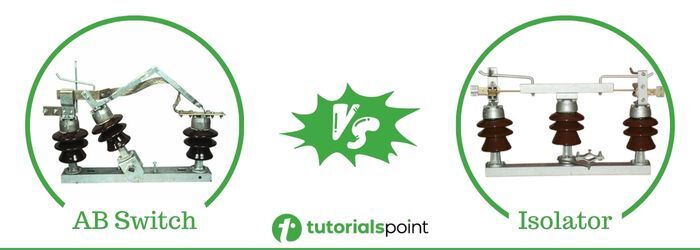
 Data Structure
Data Structure Networking
Networking RDBMS
RDBMS Operating System
Operating System Java
Java MS Excel
MS Excel iOS
iOS HTML
HTML CSS
CSS Android
Android Python
Python C Programming
C Programming C++
C++ C#
C# MongoDB
MongoDB MySQL
MySQL Javascript
Javascript PHP
PHPPhysics
Chemistry
Biology
Mathematics
English
Economics
Psychology
Social Studies
Fashion Studies
Legal Studies
- Selected Reading
- UPSC IAS Exams Notes
- Developer's Best Practices
- Questions and Answers
- Effective Resume Writing
- HR Interview Questions
- Computer Glossary
- Who is Who
Difference between AB Switch and Isolator
In electrical power systems, different types of switchgear devices are used such as circuit breakers, AB switches, isolators for switching and protection purposes. These switching devices play an important role in power systems.
There are two common types of switch devices used in electrical power systems are AB Switch (Air Break Switch) and Isolator. Although, the primary purpose of both AB switch and isolator is similar, but they are completely from each other in construction, operation, and many other aspects.

For an electrical engineer, it is very essential to understand the differences between AB switch and isolators to design and implement efficient and reliable electric systems. In this article, we will explain all the important differences between AB switch and isolator along with their basic introduction.
What is an AB Switch?
AB (Air Break) is an electrical switch used in distribution feeders, switchyards, substations, etc. for interrupting the flow of electric current in a part of a network. It is called an AB switch because it uses air as the medium for quenching the arc. In other words, the operation of an AB switch takes place in the open air. It is provided in medium and high voltage electrical systems for safety and maintenance purposes.
AB switches are known for their ability to handle high voltages and currents. These switches can work efficiently in harsh environmental conditions because they have a robust design and construction. In general, the AB switches installed in outdoor electrical systems.
An AB switch is operated with the help of a pipe and a handle, where the handle is fitted at a place on the ground suitable for its operation. The handle can be moved in upward or downward directions with the help of the square pipe. There are two states of the AB switch called, opened and closed which are explained below −
When the AB switch is in its closed state, its main contacts make a physical contact with each other and allow the flow of current in the circuit.
When the AB switch is in its open state, there is a visible gap between its main contacts and no current flow through the circuit.
AB switches are widely used in electrical power systems in the following installations −
Substations
Distribution and transmission systems
AB switches are used in these electrical installations because of the following major benefits −
Enhanced safety during maintenance and repair,
Reliable operation as a visible isolation of the contacts,
Less expensive, etc.
So, this is all about AB (Air Break) switch and its working and advantages. Let us now discuss about another switching device called isolator.
What is an Isolator?
An isolator is an off-load disconnector switch which is used in electrical systems to ensure safety during maintenance and repair work. It is called an off-load device because it must be operated only when no power is flowing in the circuit, otherwise, it will get damaged. Isolators are used in low to high voltage circuits to ensure the safety of operating personnel as well as equipment. Similar to AB switch, isolators provide a visible separation between its contacts that shows the circuit is isolated.
In electric power systems, the following are some common places where isolators are provided −
Switchyards in power generating stations
Electrical substations
Distribution feeders
Transmission lines, etc.
Isolator is also a cost-effective device for ensuring safety during maintenance of electrical systems.
Difference between Isolator and AB Switch
The following table lists all the major differences between an Isolator and an AB switch −
| Parameter | AB Switch | Isolator |
|---|---|---|
| Basic | AB (Air Break) switch is an electrical switch used for providing isolation in an electrical circuit. | Isolator is a mechanical switch used for disconnecting a circuit under no-load condition. |
| Primary purpose | AB switches can be used for both isolation and switching purposes. | Isolators are mainly designed to used for isolation purpose on no-load condition. |
| Types | AB switches can be of two types namely, single-pole AB switch and gang-operated AB switch. | Isolators can be of several types like single-break isolator, double-break isolator, and pantograph isolator. |
| Operation | AB switches can be operated in no-load condition as well as normal load conditions if an arc-quenching device is provided. | Isolators are designed only to operate under no-load conditions. |
| Also known as | AB switch can also be referred to as a circuit breaker. | Isolator is also known as a disconnector. |
| Applications | AB switches are commonly used in distribution systems, substations, switchyards, industrial and commercial installations, etc. | Isolators are used in substations, transmission lines, distribution feeders, power generating stations, industrial substations, etc. |
Conclusion
The primary purpose of both air-break switch and isolator is the same, i.e., providing isolation in the circuit and ensure safe maintenance and repair job. Basically, an air-break switch is an advanced version of isolator. Both devices are widely used in electrical substations and distribution networks.

